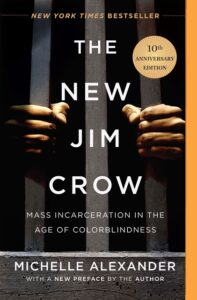Last week I stated that I wouldn’t be writing much of my own words in these posts this month, and already I must amend that. While I am very excited to dive into some Michelle Alexander, there is other business to attend to. This week is the exception as we have our Community Meeting after service with the Ohio Health Department covering our new partnership with their Harm Reduction and Northwest Ohio Syringe Service program that will be held the same time as our Food for Thought mobile pantry (as well as providing naloxone [NARCAN] training for all who want it  Sunday). At a glance, the name “Northwest Ohio Syringe Services” program and the idea of NARCAN training can be a bit scary and may put some people off. So, I’d like to break down a few things that will be covered this Sunday after service, and why it is the work of the Church to get involved in this.
Sunday). At a glance, the name “Northwest Ohio Syringe Services” program and the idea of NARCAN training can be a bit scary and may put some people off. So, I’d like to break down a few things that will be covered this Sunday after service, and why it is the work of the Church to get involved in this.
One of the first concerns that can come to mind is, by hosting this site will people be using Trinity as a space to use their needles, etc.
The answer is no. St. Paul’s Methodist hosts the NOSS program once a week and that has yet to be an issue. Part of the agreement of hosting these sites is that the guests who use the service will not do any of that.
What does NOSS provide? (as pulled from their website you can access here)
– Answers to questions about treatment options
– Injection-site wound evaluation
– Safer sex supplies
– Safer injection education
– Overdose prevention education
– Health insurance sign-up
– Free fentanyl test strips
– HIV testing: Get your results in just 20 minutes.
– Hepatitis C testing: Get your results in just 20 minutes. If you have hepatitis C we can help you navigate the path to getting treatment
– Pregnancy testing: If there is any possibility that you might be pregnant we can provide you with a free pregnancy test. Pregnant women who inject drugs have many important decisions to make and we can give you information and referral assistance.
Do syringe programs just enable drug users to keep using? (as pulled from their website you can access here)
– Between 1991 and 1997, the US Government funded seven reports on clean needle programs for persons who inject drugs. The reports are unanimous in their conclusions that clean needle programs reduce HIV and hepatitis C transmission, and none found that clean needle programs caused rates of drug use to increase. This research can be found at: DrugWarFacts.org
As one can see, this community partnership is so much more than just providing safe syringes, it can change peoples in such a tangible way. That’s why we’ve invited the Health Department to come and answer some questions, give some training, and a presentation from 11:30-12:30 this Sunday (and lunch will be provided).So, why is the church getting involved in this? Well, we’re in the business for advocating for the world we want to live in, and when it comes to the subject of illegal drugs, Northwest Ohio has been affected hard by it. I’m sure we all have a story or connection to someone we know who has been affected by it, I know I do. But even if that were not the case, we are Americans, and the War on Drugs is one of the worst sins we share a collective part of working out repentance and seeking forgiveness.
 Continuing my theme from last week on highlighting theologians of color, I’d like to introduce you to Michelle Alexander, and she is the first of our “non-traditional” theologians to be highlighted. She is a civil rights lawyer, legal scholar, and activist that has taught at many prestigious colleges. Her book, The New Jim Crow: Mass Incarceration in the Age of Colorblindness, is one that should be required reading if you are interested in justice and the legal system of the United States.
Continuing my theme from last week on highlighting theologians of color, I’d like to introduce you to Michelle Alexander, and she is the first of our “non-traditional” theologians to be highlighted. She is a civil rights lawyer, legal scholar, and activist that has taught at many prestigious colleges. Her book, The New Jim Crow: Mass Incarceration in the Age of Colorblindness, is one that should be required reading if you are interested in justice and the legal system of the United States.
As Alexander states on page 221, the “drug war has been waged almost exclusively in poor communities of color” and most of our collective privilege has allow ourselves to distance this epidemic and cast shade and shame on those we’ve ignored. While I did not grow up with memories of the start of the War on Drugs, or Nancy Regan her “just say no” clip, I did have a cultural sense of how and why it started. In the quote below, Alexander will go into a bit of the origin of the War on Drugs and the part the CIA had to play in it, but more importantly how it has disproportionally affected communities of color.
“Most people assume the War on Drugs was launched in response to the crisis caused by crack cocaine in inner-city neighborhoods. This view holds that the racial disparities in drug convictions and sentences, as well as the rapid explosion of the prison population, reflects nothing more than the government’s zealous-but benign-efforts to address rampant drug crime in poor, minority neighborhoods. This view, while understandable, given the sensational media coverage of crack in the 1980’s and 1990’s, is simply wrong. While it is true that the publicity surrounding crack cocaine led to a dramatic increase in funding for the drug war (as well as sentencing policies that generally exacerbated racial disparities in incarceration rates), there is no truth to the notion that the War on Drugs was launched in response to crack cocaine. . . the CIA admitted in 1998 that guerrilla armies it actively supported in Nicaragua were smuggling illegal drugs into the united states – drugs that were making their way onto the streets of inner-city black neighborhoods in the form of crack cocaine. The CIA also admitted that, in the midst of the War on Drugs, it blocked law enforcement efforts to investigate illegal drug networks that were helping to fund its covert war in Nicaragua.
It bears emphasis that the CIA never admitted (nor has any evidence been revealed to support the claim) that it intentionally sought the destruction of the black community by allowing illegal drugs to be smuggled into the United States. Nonetheless . . . in light of the devastation wrought by crack cocaine and the drug war, and the odd coincidence that an illegal drug crisis suddenly appeared in the black community after -not before- a drug war had been declared. IN fact, the War on Drugs began at a time when illegal drug use was on the decline. During this same time period, however, a war was declared, causing arrests and convictions for drug offenses to skyrocket, especially among people of color. The impact of the drug war has been astounding. IN less than thirty years, the U.S. penal population exploded from around 300,000 to more than 2 million, with drug convictions accounting or the majority of the increase.”
– Michelle Alexander, The New Jim Crow, pg. 6&7
Engaging with our community means asking, how can we support those who are around us. The effects of the War on Drugs are still ongoing, whether from addiction or penal sentencing, so as we continue to listen and have our hearts broken by what is going on around us, may we open our arms, hearts, and church to those who need us most.
Michelle Alexander’s book is available at www.newjimcrow.com
Grace and peace,
George Benson (he/him)
(picture credit, NOSS: Health Department, The New Jim Crow, newjimcrow.com)
